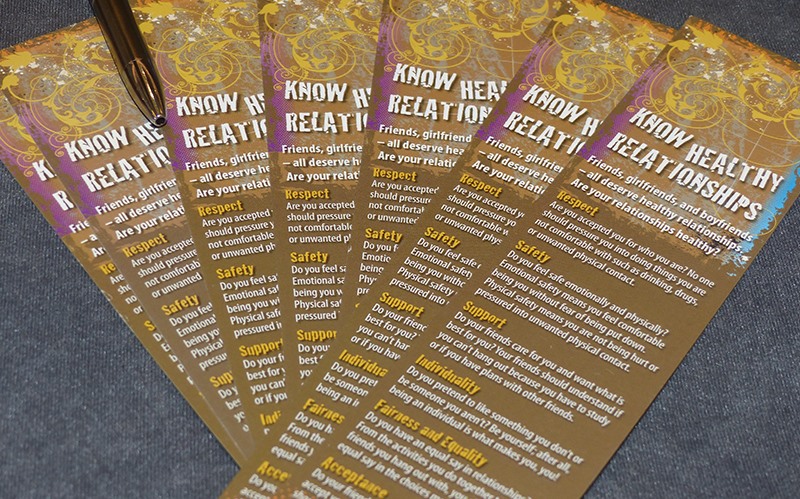|
STORY AND PHOTOS BY KAREN BOSSICK Idaho, we have a problem. The Gem State may be the eighth happiest state in the nation, but it’s not so happy when it comes to bullying. In fact, Idaho students report the second highest rate of bullying in the country, according to data collected by the Centers for Disease Control and Prevention’s Youth Risk Behavior Surveillance System.
|
|

Students created their interpretation of healthy relationships during an open house sponsored by The Advocates last year.
|
|
|
According to the study, 25.8 percent of Idaho high school students reported being bullied on school property. The cyberbullying rate among Idaho high school students was also the second highest in the nation with 20.3 percent reporting being cyber-bullied. Thirty-five percent of the high school students reported feeling sad or hopeless, as well—the seventh highest in the nation. The Advocates are trying to do something about it with their Green Dot bystander program as National Bullying Prevention Month gets under way. The Advocates introduced the Green Dot program into Blaine County high schools a few years ago and are expanding it into elementary schools this year.
|
|

The Advocates have plenty of informational material about bullying and healthy relationships to pass on to those who would like some.
|
|
|
The program, which basically assures others, “I have your back,” was started in Kentucky where the program was introduced in 13 schools. The results were then measured against 13 schools that did not have the program. Violence was cut by half in the schools that incorporated the program. The program was called the Green Dot bystander program with the idea that a Red Dot pops up every time someone makes a choice to harm someone. A green dot then pops up every time someone tries to diffuse the red dots. “For us, the 50 percent cut was a huge number because we had never seen much of a shift with anything else that was tried. We’d seen things drop maybe 2 percent,” said Darrel Harris, social change coordinator for The Advocates. “The focus has been on young people. But we need to recognize that everyone plays a role, no matter what age. I have a granddaughter and I want a world in which she can grow up happy and healthy and safe.” The Green Dot program gives youngsters—and adults—tools they can use to safely and effectively intervene when they see others being bullied or harassed. The tools:
* Direct responses in which someone intervenes to say, “Is everything okay here?” or even, ‘Hey, this is inappropriate.” * Diffusing the situation by getting help from another bystander, teacher, police officer. * Creating a diversion, such as spilling a cup of coffee or interrupting to ask direction to deescalate a potentially violent situation. “We believe that for every act of violence, whether bullying or sexual harassment, there is a moment when someone can step in to stop it,” said Harris. “We all have a lot of obstacles to standing up and they’re all valid. But when we do step up, it decreases the likelihood that something bad gets worse.”
Burger King recently videotaped an experiment in which high school students pretended to bully a schoolmate. Burger King then videotaped customers’ reactions to a Burger King employee who smashed burgers before handing them to customers. Nine-five percent of the customers reported the bullied Whopper and the bullying counter clerk to the store manager. Only 12 percent stood up for the bullied student in the videotape, which is shown on YouTube. Bullying includes posting inside jokes or pictures on Facebook, sharing private personal information on Facebook and blackmail, said Heidi Cook, violence prevention educator for The Advocates. “Ask yourself: What if it was someone I loved? Then check in with the target. Ask them, ‘Anything I can do?’ ” she said.
“If enough people are committed, if enough people say I’m going to be part of this new norm, it will reduce the number of episodes,” she added. “There is always something you can do and it doesn’t have to be a huge deal.” High school student Jessie Lambert, one of The Advocates’ interns, said she’s watched friends pick on other students. “The person getting picked on doesn’t say anything but it probably hurts them,” she said. “I always try to go to them and say, ‘Hey, I’m with you. This is stupid.’” Audra Mary said she sometimes has students come to her wanting to know how to handle a situation since she’s an Advocates intern.
“I’ve gone to the school counselor and said, ‘This is what I’ve heard,’ ” she said. “It’s hard because when the kids being affected watch their other friends do nothing, they think they’re so alone.” BULLYING ACROSS THE STATES Arkansas had the highest rate of high school bullying, according to 24/7 Wall Street, which reviewed the study compiled by Centers for Disease Control and Prevention’s Youth Risk Behavior Surveillance System The study reported that 26.6 percent of Arkansas students said they’d been bullied on school property; 19.7 percent were cyber-bullied and 40.2 percent reported being sad or hopeless.
North Dakota was in third place, followed by Wisconsin, Louisiana, Wyoming, West Virginia, Missouri, Delaware, Massachusetts and Virginia. Minnesota, Oregon, Vermont and Washington were not included in the analysis. Wall Street 24/7 reports that children who are perceived as being different from their peers are more likely to experience bullying. Overweight children are one of the most commonly targeted groups. Children are less likely to engage in bullying if they have high self-esteem and are more involved in school. Studies have shown that high levels of aggression tend to correspond with low levels of academic achievement. Many of the same factors that may increase the likelihood of bullying victimization also contribute to high rates of mental stress, said Wall Street 24/7. In eight of the 10 states with the lowest prevalence of bullying, the share of high school students who report feeling sad or hopeless so much that they stop engaging in their usual activities is less than the 31.5% national share.
States may be able to prevent bullying with anti-bullying legislation and programs. An October 2015 study published by The Journal of the American Medical Association found that students in states with at least one legislative component recommended by the DOE were 24% less likely to report bullying and 20% less likely to report cyberbullying.
|